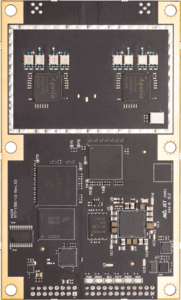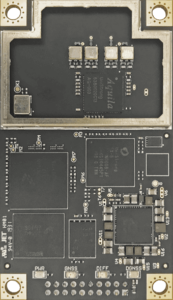Hemisphere GNSS have introduced new OEM GNSS receiver boards, driven by Lyra II digital ASIC and Aquila wideband RF ASIC technology. The new ASIC (application-specific integrated circuit) technology delivers industry-leading performance and precision.

Hemisphere GNSS Vega 40 GNSS Compass Board
The five new positioning and heading OEM boards, the first products to incorporate this powerful new technology, will be showcased at INTERGEO in Stuttgart and at ION GNSS+ in Miami this September.
The five new OEM positioning and heading boards are:
- Phantom 20
- Phantom 34
- Phantom 40
- Vega 28
- Vega 40.
The next-generation technologies feature Lyra II – Hemisphere’s best-in-class digital ASIC, and Aquila – wideband RF ASIC. This technology optimizes performance and can track and process over 800 channels for position-only (Phantom series boards) and over 1,100 channels for position and heading (Vega series boards).
Lyra II and Aquila ASIC technology form the foundation for a new GNSS receiver chipset which reduces the number of board components and thereby reduces complexity, improves reliability and dramatically lowers power consumption.
Hemisphere’s new Cygnus interference mitigation technology also features. Complete with built-in digital filtering capabilities and spectrum analysis, Cygnus technology provides enhanced anti-jamming, interference detection and mitigation.
Find suppliers and manufacturers of GNSS Receivers for UAVs >

Hemisphere GNSS Phantom 20 and 34 GNSS OEM Boards
The new ASIC technology offers flexible and scalable access to every modern and planned GNSS constellation and signal, including:
- GPS
- GLONASS
- Galileo
- BeiDou
- QZSS
- IRNSS
- SBAS
- Hemisphere’s Atlas L-band
Signal support and tracking for AltBOC and BS-ACEBOC, BeiDou phase 2 and phase 3, L5, and QZSS/L6 (L6-D and L6-E) are also available.
Hemisphere’s president and chief executive officer, Farlin Halsey said; “This new technology platform and OEM boards represent significant improvements upon previous generation technology and hardware that truly make them best-in-class and industry-leading. With these outstanding advancements in our core technology and hardware, our customers and OEM partners are future-proofed and have flexibility and scalability with the highest-value access to all modern and planned signals.”
Phantom GNSS OEM Boards
The Phantom 20, 34, and 40 positioning boards are multi-frequency, multi-GNSS receivers that boast more than 800 channels, including access to Hemisphere’s Atlas GNSS global corrections network. They offer power consumption of less than 1.8 W when tracking all signals, including L-band and also offer Serial, USB, Ethernet (Phantom 40-only), and CAN connectivity..
Specifications:
- Phantom 20 (41 x 72mm module with 20-pin header)
- Phantom 34 (41 x 71 mm module with 34-pin header)
- Phantom 40 (60x 100 mm module with 24-pin and 16-pin headers)
Vega GNSS Compass Boards
The Vega 40 and 28 are low-power, high-precision, positioning and heading OEM boards, offering multi-frequency, multi-GNSS access to more than 1,100 channels including Hemisphere’s Atlas GNSS global corrections network.
Specifications:
- Vega 40 is a 60 x 100 mm module with 24-pin and 16-pin headers – the ideal upgrade for existing designs using this industry-standard form factor.
- Vega 28 is a 45 x 71 mm module with 28-pin header – is Hemisphere’s smallest GNSS OEM heading module.
Hemisphere GNSS will be featuring these all-new OEM positioning and heading boards at INTERGEO in Stuttgart 2019, September 17 – 19 and at ION GNSS+ in Miami 2019, September 18 – 19.
Find suppliers and manufacturers of GNSS Receivers for UAVs >


















